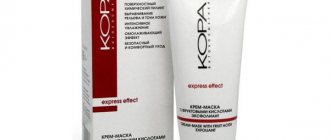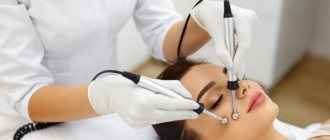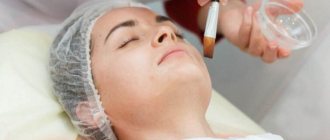The most popular facial cleansing is manual. It is not recommended to do it at home on your own, but many still neglect this rule. What is manual cleaning? Before starting, the skin is thoroughly steamed so that the pores open and are easily exposed. After this, the cosmetologist manually squeezes out the blackheads, thereby cleansing the skin. Next, the skin is disinfected and a mask is applied to it, which will help tighten the pores. It is worth noting that this procedure is effective, but very painful.
Mechanical cleaning is very similar to manual cleaning. Immediately before the procedure, the specialist applies a special warming mask to the skin. Pores are cleaned using a special spoon. The duration of the procedure is approximately 1 hour.
You can get rid of old skin particles using chemical peeling. A solution of special acids will be applied to your face, after which your skin can be compared to the skin of a baby. It is noteworthy that this type of peeling is available to many, because its prices are affordable.
If you are the “lucky” owner of oily skin, then ultrasonic facial cleansing is ideal for you. The skin is cleansed using special sound vibrations. The result, which will undoubtedly please you, will last for a long time. By the way, if you have any skin diseases, then you cannot use this method.
Any salon facial cleansing should be done before the weekend, since after it you shouldn’t apply makeup for a couple of days, and you will really want to do this, because your facial skin will be unnaturally reddish.
Main signs of contaminated skin
The epidermis of the face is the most vulnerable and unprotected area of the skin, constantly in contact with the external environment and exposed to its negative influences. During the day, a lot of contaminants accumulate on the surface of the face: particles of dust, precipitation, gases, remnants of decorative cosmetics and care products, sebum, dead cells. Insufficient cleansing can cause deterioration of the skin condition.
The first signs of epidermal contamination:
- Dull, uneven skin texture.
- Enlarged pores, feeling of an oily film on the face.
- An abundance of blackheads, small pimples, comedones.
When these symptoms occur, the usual washing becomes insufficient, and the beauty routine must be supplemented with the obligatory stage of deep cleansing of the facial skin.
Why is it important to cleanse your facial skin?
The surface of the epidermis is normally inhabited by a variety of bacteria, fungi, viruses - the totality of microorganisms forms an individual microbiome for each person. External pollution contributes to disruption of microflora, damage to the hydrolipid barrier and a decrease in the protective functions of the skin.
Functions of regular and thorough facial cleansing:
- Helps maintain a balance of beneficial microorganisms on the skin surface.
- Prevents pore contamination, the appearance of comedones and blackheads.
- Removes the stratum corneum of cells, promotes cellular renewal and prevents premature aging: the appearance of wrinkles, decreased tone, elasticity and firmness of the skin.
- Improves the ability of cells to absorb beneficial components from care formulas.
- Controls the functioning of the sebaceous glands and regulates oily skin: stress, lack of sleep, taking certain medications, an unbalanced diet - all this causes increased sebum production, as a result of which rashes can appear even on skin that is not prone to acne.
- Prevents oxidative stress and the negative effects of free radicals.
How to cleanse your facial skin: 3 main methods
You can cleanse your skin using three types of procedures; use them in combination for the best effect:
- Daily cleansing at home
is a mandatory skin care procedure for any type of skin, aimed at removing makeup, delicately removing residual external impurities from the face and preparing for the application of tonic and corrective products. - Weekly deep cleansing at home
- exfoliation of the stratum corneum and intensive cleansing of the skin at a deeper level using scrubs, peelings, gommages, masks. The frequency of procedures depends on the type and condition of the skin. - Salon cleansing procedures
are cosmetology services aimed at professional hardware facial cleansing, deep cleansing and skin renewal using seasonal dermal peels and highly concentrated masks. The frequency of procedures depends on the type and condition of the skin.
When and who should not cleanse?
Many people believe that visiting a beauty salon or similar manipulations at home on their own is allowed for absolutely everyone.
This is a deep misconception. Mechanical facial cleansing has a number of prohibitions:
- acute dermatitis;
- herpetic rashes;
- eczema;
- dry or sensitive skin;
- any manifestations of allergies;
- inflammatory skin diseases;
- blood diseases;
- hypertension;
- bronchial asthma.
You should not clean your face during menstruation or with pronounced premenstrual syndrome.
The tendency to inflammation is also an obstacle to the procedure.
Indications for mechanical facial cleansing:
- large pores;
- excessive skin greasiness;
- the presence of wen in large quantities;
- decreased skin turgor;
- blackheads, especially in the T-zone.
Important. Mechanical facial cleansing gives a pronounced lifting effect by improving the movement of blood and lymph in the upper layers of the epidermis.
How to properly carry out daily cleansing: instructions
Facial cleansing is the longest and most important skin care procedure that is performed at home and depends on you. It consists of several basic stages.
Preparation or makeup removal
The stage of removing surface impurities that have accumulated on the surface of the skin during the day or night.
Many people neglect morning cleansing, believing that the epidermis did not have time to get dirty overnight. While we sleep, the body's metabolic processes are continuously working, internal cleansing and cell restoration occur. For example, the peak of sebum production occurs at 4–5 o'clock in the morning, so it is important to take care of cleansing the facial skin twice a day (more often it is not recommended so as not to damage the hydrolipid mantle).
The following products are suitable for makeup removal:
- micellar water (for all skin types);
- milk (for dry and sensitive types);
- cleansing lotion (often does not require rinsing with water);
- Makeup remover wipes (travel version).
Washing (basic cleansing)
The second step is to wash your face with water and cleanser. At this stage, you need to cleanse the facial skin of any remaining impurities dissolved in the first stage and completely empty the pores.
There are special products for washing:
- for oily and combination skin – foams with a sebum-regulating effect, facial gels + “2 in 1” scrub;
- for sensitive people – soft mousses, foams;
- for dry and dehydrated skin – moisturizing and softening milk, cream, balm.
Apply a small amount of product to damp facial skin. Then use gentle circular movements with your fingertips to massage the entire surface of your face, avoiding the eye area. Finally, rinse off the cleanser with water and pat your face dry with a clean, soft towel.
Moisturizing and toning
The final, but not the last most important stage of cleansing is skin moisturizing. After washing your face, wipe your dry face with a cotton pad soaked in a toner with a moisturizing formula. This will restore the pH balance of the epidermis, prepare for the further corrective stage of care and improve the penetration of beneficial components from care cosmetics into the deep layers of the skin.
What can mechanical cleaning be combined with?
If the procedure is carried out at home, it is recommended to supplement it with various masks, scrubs and tonics.
This is done both before cleaning and after its completion, and allows you to achieve an effect close to that of a salon, plus it helps the skin recover faster after a traumatic intervention.
Pre-cleaning steps
Procedures applied immediately after steaming:
- Film mask made of gelatin and activated carbon. Crush half a tablet of activated carbon (black) into powder, add 1 tsp. gelatin and the same amount of boiled cool water. Mix everything and put it in the microwave or in a water bath. The mixture should become homogeneous and liquid. Using a brush with natural hard bristles, apply the mask to your face and wait until it dries. Gently pick it up from one edge and remove the film, being careful not to tear it.
- Clay mask. Mix 1 tsp. white and blue clay, pour a cool decoction of chamomile onto the eye. The consistency of the mixture should resemble homemade sour cream. Apply the mask to your face, paying special attention to the T-zone. Wait until it dries, then rinse with cool water. Wash yourself with chamomile decoction.
- Natural peeling. Powder a couple of tablespoons of almonds, add a little kefir (1%) and mix. Apply the resulting thick mass to your face and massage vigorously but gently with your fingertips, paying special attention to the T-zone. Wash your face without soap. Rinse your face with chamomile infusion (you can use yarrow infusion).
Advice. Immediately after the recipes described above, facial cleansing is not done. It is necessary for at least a day to pass for the skin to rest a little.
After this, repeat all the steps described in the Procedure Technique, including steaming, and remove what the masks and (or) scrub could not remove.
How to cleanse different skin types?
In order to cleanse your facial skin properly and maintain its health and youth, you need to choose special cosmetics for washing that are suitable specifically for your skin type.
After all, insufficient cleansing can lead to clogged pores and the appearance of acne. And too zealous cleansing can disrupt the skin's hydrolipid mantle and lead to dehydration. Therefore, choose cosmetics from reliable brands and be sure to pay attention to the label; most products indicate what type of skin it is intended for.
Oily skin
Oily skin types are characterized by enlarged pores, increased sebum production and a greasy shine. That is why cleansers should have a sebum-regulating function, tighten pores, clean thoroughly, but at the same time provide the skin with moisture and not dry it out. Oily skin, like any other, needs hydration.
For such facial skin, cosmetics containing thermal water, kaolin and zinc are well suited. Keep in mind that the composition should not contain ethyl alcohol!
Dry skin
Dry skin is usually quite thin and sensitive, it requires gentle and careful cleansing. Cleansers for dry skin types should be gentle and softening, have restorative functions, and should not contain alcohol. Most often these are creams, mousses or foams.
The exfoliation procedure should be approached with caution and the means chosen wisely. Scrubs with rough abrasive particles can damage dry skin.
Normal skin
Lucky people with normal skin type have the widest choice among cosmetics. They are not limited by either product types or textures. Suitable products must be labeled “for normal skin” or “for all skin types.”
Combination skin
Those with combination or mixed skin types will have to adapt when looking for cleansers. This is necessary so as not to harm the already dry areas of the skin in the U-zone. If after washing your face there is a feeling of tightness, then the product is not suitable for you. It is better to stick to products for dry or normal skin types.
Technique for deep skin cleansing at home
Deep cleansing and exfoliation (exfoliation) of the skin is primarily necessary for oily skin types with a predisposition to acne - dead skin cells of the epidermis mix with sebum and clog pores, causing rashes.
Important(!):
To exfoliate the skin, use soft scrubs with small natural abrasive particles or mineral masks, carry out the procedure 1-2 times a week.
Other types (dry, normal) also need deep cleansing - corneocytes (dead cells of the epidermis) disrupt the functioning of the sebaceous glands and prevent the penetration of active cosmetic substances into the dermal layers. Without sufficient cleansing, the skin loses its tone, elasticity, becomes dull in color and uneven in texture.
Carry out the exfoliation procedure once a week, choose delicate peelings or soft gommages. Look for products labeled “hypoallergenic” and “suitable for sensitive skin” on the packaging.
Important(!):
When caring for very sensitive skin prone to allergic reactions, it is worth excluding the stage of skin exfoliation so as not to injure the already weakened epidermis.
Is it worth doing deep facial cleansing at home?
It is impossible to answer this question unequivocally. Salon cleaning can go wrong if you get to an inexperienced specialist.
The solution here is simple - choose a salon that has proven itself well.
At the same time, a procedure carried out at home in compliance with all recommendations can give an excellent effect, as close as possible to the salon effect.
Should you do deep facial cleansing at home? Yes, and this procedure has many advantages:
- Time and place. Everything takes place in a cozy home environment, which temporarily turns into a beauty salon. During the procedure, you can relax without thinking about your appearance.
- Delicate impact. If you approach deep cleansing wisely, consequences such as redness and pain can be minimized.
- Possibility of using additional agents to relieve inflammation.
- Minimal risk of allergic reactions. All manipulations are carried out using natural (not chemical) substances.
On a note. Before deep cleansing your face, determine your skin type. This will help you choose the right products for the procedure.
Methods for cleaning leather in the salon
Cosmetologists also offer a list of aesthetic procedures aimed at deep cleansing and renewal of the epidermis, for example, chemical and hardware exfoliation of the facial skin. Such procedures involve the use of acids and enzymes that literally dissolve the stratum corneum of cells.
Important(!):
After chemical or acid peeling, the photosensitivity of the skin increases. Be sure to use a daily sunscreen with at least SPF 30 to prevent photoaging.
The most popular salon procedures for deep cleansing of facial skin:
- Ultrasonic cleansing (ultrasonic peeling) – cleansing pores of excess sebum and dead cells by exposure to ultrasonic waves.
- Vacuum cleaning is a gentle hardware method of cleansing the skin. The procedure effectively cleanses pores, gets rid of blackheads, and tightens the oval of the face due to the lymphatic drainage effect.
- Mechanical (manual) cleaning is the most traumatic and effective procedure for cleansing clogged pores. A classic option for cleansing the skin using a loop spoon (UNO).
- Galvanic (disincrustation) cleansing is suitable for thick, oily skin: a salt solution is used and microcurrents are applied to the skin. As a result of the procedure, the pores are cleaned, blackheads and comedones disappear.
- Microdermabrasion (resurfacing) is aimed at intensive renewal of the epidermis and smoothing out stagnant spots (post-acne).
Recommendations from cosmetologists
To prolong the effect of home facial cleansing, it is recommended to follow the following rules:
- cleanse before bed;
- on the first day, before going outside, you should apply a cream that protects against ultraviolet radiation;
- Minimize exposure to the sun for several days after the procedure;
- do not visit the sauna and bathhouse for at least 7 days;
- do not forget to use moisturizer;
- Make a nourishing mask every 7-10 days.
Facial cleansing at home is a fairly simple procedure that you can easily do yourself. It will not only help get rid of unpleasant rashes, but also restore youth and freshness.










